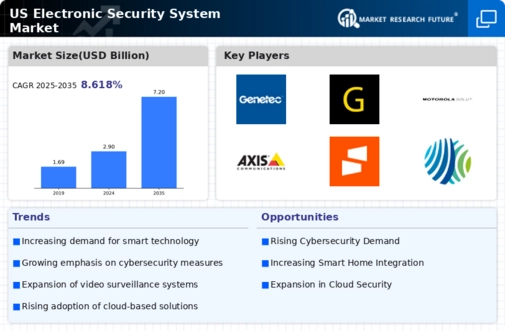Increasing Crime Rates
The rising incidence of crime in urban areas appears to be a primary driver for the electronic security-system market. As communities face heightened concerns regarding theft, vandalism, and other criminal activities, the demand for advanced security solutions intensifies. According to recent data, property crime rates in the US have shown a notable increase, prompting both residential and commercial sectors to invest in electronic security systems. This trend indicates a shift towards more sophisticated technologies, such as surveillance cameras and alarm systems, which are perceived as essential for safeguarding assets. Consequently, the electronic security-system market is likely to experience substantial growth as consumers prioritize safety and security in their purchasing decisions.
Technological Advancements
Rapid advancements in technology significantly influence the electronic security-system market. Innovations such as high-definition video surveillance, smart sensors, and cloud-based storage solutions are transforming the landscape of security systems. The integration of these technologies enhances the functionality and effectiveness of security measures, making them more appealing to consumers. For instance, the market for video surveillance equipment alone is projected to reach approximately $20 billion by 2026, reflecting a compound annual growth rate (CAGR) of around 10%. This technological evolution not only improves security but also offers users greater control and flexibility, thereby driving demand within the electronic security-system market.
Consumer Awareness and Education
Growing consumer awareness regarding security threats and the importance of protective measures is a significant driver for the electronic security-system market. As individuals become more informed about potential risks, they are more inclined to invest in security solutions that offer peace of mind. Educational campaigns and increased media coverage of security breaches have contributed to this heightened awareness. Consequently, consumers are actively seeking out electronic security systems that provide comprehensive protection. This trend is evident in the rising sales of home security systems, which have seen a growth of approximately 15% annually. As awareness continues to rise, the electronic security-system market is expected to flourish, driven by informed purchasing decisions.
Integration of Smart Technologies
The integration of smart technologies into security systems is reshaping the electronic security-system market. As smart home devices gain popularity, consumers are increasingly looking for security solutions that can seamlessly integrate with their existing smart ecosystems. This trend is evidenced by the growing demand for smart locks, video doorbells, and connected alarm systems, which enhance convenience and control for users. The market for smart home security solutions is projected to reach $10 billion by 2027, indicating a robust growth trajectory. As more households adopt smart technologies, the electronic security-system market is likely to benefit from this convergence, leading to innovative product offerings and enhanced user experiences.
Regulatory Compliance and Standards
The electronic security-system market is increasingly shaped by regulatory compliance and industry standards. Various sectors, including finance, healthcare, and education, are subject to stringent security regulations that mandate the implementation of robust security measures. Compliance with these regulations often necessitates the adoption of advanced electronic security systems, which can lead to increased market growth. For example, the Health Insurance Portability and Accountability Act (HIPAA) requires healthcare organizations to secure patient data, thereby driving the demand for electronic security solutions. As organizations strive to meet these compliance requirements, the electronic security-system market is likely to expand, reflecting the critical role of security in maintaining operational integrity.






















Leave a Comment